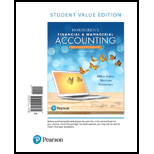
Horngren's Financial & Managerial Accounting, The Financial Chapters, Student Value Edition Plus MyLab Accounting with Pearson eText -- Access Card Package (6th Edition)
6th Edition
ISBN: 9780134642864
Author: Tracie L. Miller-Nobles, Brenda L. Mattison, Ella Mae Matsumura
Publisher: PEARSON
expand_more
expand_more
format_list_bulleted
Question
Chapter 8, Problem 20RQ
To determine
Note receivable:
Note receivable refers to a written promise for the amounts to be received within a stipulated period of time. This written promise is issued by a debtor or borrower to lender or creditor. Notes receivable is an asset of a business.
Interest on note receivable:
Interest on note receivable is the amount charged on the principal value of note for the privilege of borrowing money. Interest is to be paid by the borrower and to be received by the lender.
To show: The formula used to compute the interest on note receivable.
Expert Solution & Answer
Want to see the full answer?
Check out a sample textbook solution
Students have asked these similar questions
How much overhead or over absorbed ?
Account Subject Questions. Answer me carefully
Solve Question. General accounting
Chapter 8 Solutions
Horngren's Financial & Managerial Accounting, The Financial Chapters, Student Value Edition Plus MyLab Accounting with Pearson eText -- Access Card Package (6th Edition)
Ch. 8 - Prob. 1QCCh. 8 - Which of the following is a limitation of the...Ch. 8 - The entry to record a write-off of an...Ch. 8 - Brickman Corporation uses the allowance method to...Ch. 8 - Brickmans ending balance of Accounts Receivable is...Ch. 8 - 6. During the year, Bernard Company had net credit...Ch. 8 - At December 31 year-end, Crain Corporation has an...Ch. 8 - Using the data in the preceding question, what...Ch. 8 - At year-end, Schultz, Inc. has cash of 11,600,...Ch. 8 - Using the data in the preceding question, assume...
Ch. 8 - What is the difference between accounts receivable...Ch. 8 - Prob. 2RQCh. 8 - Prob. 3RQCh. 8 - When dealing with receivables, give an example of...Ch. 8 - What type of account must the sum of all...Ch. 8 - Prob. 6RQCh. 8 - What occurs when a business factors its...Ch. 8 - What occurs when a business pledges its...Ch. 8 - Prob. 9RQCh. 8 - Prob. 10RQCh. 8 - Prob. 11RQCh. 8 - Prob. 12RQCh. 8 - When using the allowance method, how are accounts...Ch. 8 - Prob. 14RQCh. 8 - Prob. 15RQCh. 8 - How does the percent- of-sales method compute bad...Ch. 8 - How do the percent-of-receivables and aging-of-...Ch. 8 - What is the difference between the...Ch. 8 - Prob. 19RQCh. 8 - Prob. 20RQCh. 8 - Prob. 21RQCh. 8 - Prob. 22RQCh. 8 - Prob. 23RQCh. 8 - Prob. 24RQCh. 8 - Prob. 8.1SECh. 8 - Prob. 8.3SECh. 8 - Prob. 8.4SECh. 8 - Prob. 8.5SECh. 8 - Prob. 8.6SECh. 8 - Prob. 8.7SECh. 8 - Prob. 8.8SECh. 8 - Prob. 8.9SECh. 8 - Prob. 8.10SECh. 8 - Prob. 8.11SECh. 8 - Prob. 8.12SECh. 8 - Prob. 8.13SECh. 8 - Defining common receivables terms Match the terms...Ch. 8 - Prob. 8.15ECh. 8 - Prob. 8.16ECh. 8 - Prob. 8.17ECh. 8 - E8-18 Accounting for uncollectible accounts using...Ch. 8 - E8-19 Accounting for uncollectible accounts using...Ch. 8 - E8-20 Accounting for uncollectible accounts using...Ch. 8 - E8-21 Journalizing transactions using the direct...Ch. 8 - Prob. 8.22ECh. 8 - Prob. 8.23ECh. 8 - Prob. 8.24ECh. 8 - Prob. 8.25ECh. 8 - Prob. 8.26ECh. 8 - Prob. 8.27ECh. 8 - P8-28A Accounting for uncollectible accounts using...Ch. 8 - Prob. 8.29APCh. 8 - Prob. 8.30APCh. 8 - Prob. 8.31APCh. 8 - P8-32A Accounting for notes receivable and...Ch. 8 - Prob. 8.33APCh. 8 - Prob. 8.34APCh. 8 - Prob. 8.35BPCh. 8 - Prob. 8.36BPCh. 8 - Prob. 8.37BPCh. 8 - Prob. 8.38BPCh. 8 - Prob. 8.39BPCh. 8 - P8-40B Accounting for notes receivable, dishonored...Ch. 8 - Prob. 8.41BPCh. 8 - Prob. 43CPCh. 8 - Prob. 44PSCh. 8 - Prob. 8.1TICh. 8 - Prob. 8.1DCCh. 8 - Decision Case 8-2
Pauline’s Pottery has always...Ch. 8 - Prob. 8.1FCCh. 8 - Use Target Corporation’s Fiscal 2015 Annual Report...
Knowledge Booster
Learn more about
Need a deep-dive on the concept behind this application? Look no further. Learn more about this topic, accounting and related others by exploring similar questions and additional content below.Similar questions
- Financial accountingarrow_forwardHatfield Corporation, which has only one product, has provided the following data concerning its most recent month of operations: Selling price $158 Units in beginning inventory 100 Units produced 1,720 Units sold 920 Units in ending inventory 900 Variable costs per unit: Direct materials $59 Direct labor $37 Variable manufacturing overhead $6 Variable selling and administrative $9 Fixed costs: Fixed manufacturing overhead $15,480 Fixed selling and administrative $17,480 What is the total period cost for the month under the variable costing? A- $32,960 B- $25,760 C- $41,240 D- $15,480arrow_forwardHelparrow_forward
- How much Total sales are required to achieve a net income of 160000?arrow_forwardGeneral accounting questionarrow_forwardHamilton Biotech has a profit margin of 8% and an equity multiplier of 2.8. Its sales are $150 million, and it has total assets of $60 million. What is Hamilton Biotech's Return on Equity (ROE)? Round your answer to two decimal places.arrow_forward
- MAX's Auto Repair, a proprietorship, started the year with total assets of $72,000 and total liabilities of $48,500. During the year, the business recorded $120,600 in repair revenues, $65,400 in expenses, and MAX Grant, the owner, withdrew $12,500. MAX’s capital balance at the end of the year?arrow_forwardWhat is equity at the end of the year is?arrow_forwardPlease help mearrow_forward
arrow_back_ios
SEE MORE QUESTIONS
arrow_forward_ios
Recommended textbooks for you
- Principles of Accounting Volume 1AccountingISBN:9781947172685Author:OpenStaxPublisher:OpenStax College
 College Accounting, Chapters 1-27AccountingISBN:9781337794756Author:HEINTZ, James A.Publisher:Cengage Learning,
College Accounting, Chapters 1-27AccountingISBN:9781337794756Author:HEINTZ, James A.Publisher:Cengage Learning,

Principles of Accounting Volume 1
Accounting
ISBN:9781947172685
Author:OpenStax
Publisher:OpenStax College

College Accounting, Chapters 1-27
Accounting
ISBN:9781337794756
Author:HEINTZ, James A.
Publisher:Cengage Learning,
7.2 Ch 7: Notes Payable and Interest, Revenue recognition explained; Author: Accounting Prof - making it easy, The finance storyteller;https://www.youtube.com/watch?v=wMC3wCdPnRg;License: Standard YouTube License, CC-BY